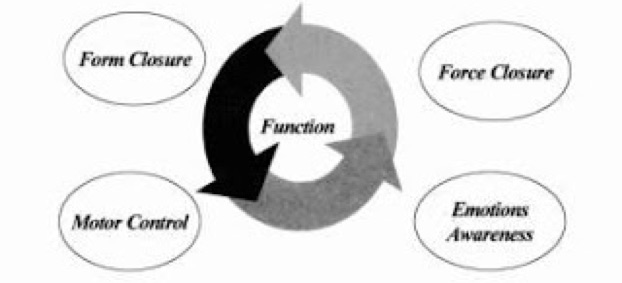Form and Force Closure Mechanism
Form closure:
The shape, structure or form of a joint provides the stability.
Force closure:
Compressive forces and congruency between two surfaces of a joint provide the friction to enhance stability.
Optimizing form or force closure enhances the stability and load bearing ability of a joint complex.
Minimizing form or force closure reduces stability and ‘de-stabilizes’ the load bearing ability, allowing for increased movement potential.

Restoring Core Function
Restoring the recruitment patterns (order in which different muscles contract) of the core is different than most exercise you will have been used to in the past.
The first step is to learn to isolate the muscle, to train it to contract.
Research has clearly shown that the better you are at isolating this muscle the faster it will integrate into functional tasks.
The second step is to strengthen or teach it to co-contract with the other muscles of the core, the deep multifidus and the pelvic floor as you breathe.
The final step is to co-contract the entire core (connect to the entire core) and use this connection in functional activities.
Core Stabilization Assessment
1. Cervical Flexor Pattern Test
2. Craniocervical Flexion Test
3. Cervical Flexion Activation
4. Forward Flexion Activation Test
5. Prone Transverse Abdominis Test
6. Low Abdominal Stability Test
7. Thoraco-Lumbar Fascia Activation Test
8. Lower Abdominal Strength Test
9. Prone Hip Extension Test
10. Lumbar Joint Shear Stability Test
11. Piedau’s Sign
12. Heel Drop Test
13. Seated Compression Test
14. Rolling Pattern (Upper/Lower)
15. Active Straight Leg Raise
Guidelines for Integrated Core Performance Training
1. Perform comprehensive assessment
2. Muscle imbalances and arthrokinematic deficits must be corrected prior to initiating aggressive training
Program should emphasize muscle contraction spectrum
1. Concentric (force production)
2. Eccentric (force reduction)
3. Isometric (dynamic stabilization)
Program must be challenging with progression through function continuum
Variables – must be modified
1. Plane of motion
2. Range of motion
3. Loading
4. Body position
5. Amount of control and speed
6. Feedback
7. Duration and frequency
Specific Guidelines
1. Proprioceptively rich program
2. Safe
3. Challenging
4. Stress multiple planes
5. Incorporate multi-sensory environment
6. Derived from fundamental movement skills
7. Activity specific
Progressive Continuum
1. Slow to fast
2. Simple to complex
3. Known to unknown
4. Low force to high force
5. Eyes open to eyes closed
6. Static to dynamic
Goal of program should be to develop optimal levels of functional strength and stabilization
1. Focus on neural adaptations instead of absolute strength gains
2. Increase proprioceptive demands
3. Quality not quantity
4. Poor technique and neuromuscular control results in poor motor patterns and stabilization
5. Focus on function
